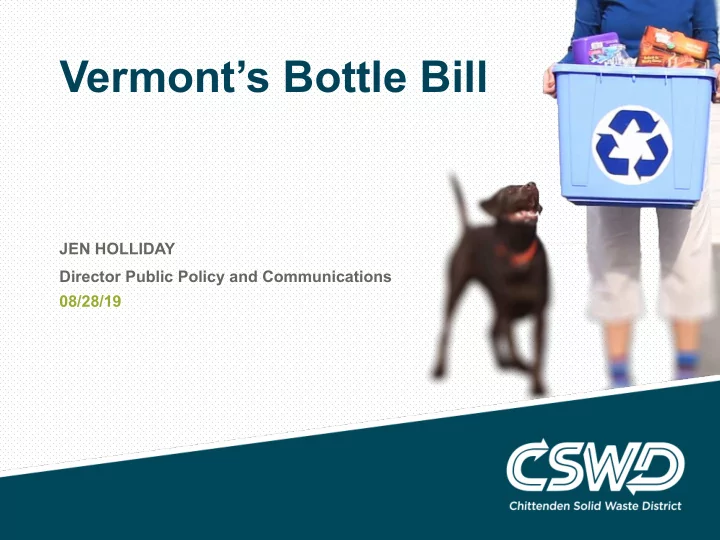

Vermont’s Bottle Bill JEN HOLLIDAY Director Public Policy and Communications 08/28/19
Why Now Bottle bill expansion considered every year Clean water legislation has given expansion consideration a big boost Many legislators in favor of an expansion Time to consider the impact to CSWD MRF and other pros and cons Alternative proposals
VT Bottle Bill Basics Enacted 1972 – litter law Includes beer or other malt beverages, mineral waters, mixed wine drinks, soda water, carbonated soft drinks and liquor. Deposit – liquor $0.15; All others $.05 Handling fee for redemption centers and retailers $.04 for brand-sorted containers and $.035 for commingled brands (approximately 50 redemption centers in VT) Escheats (unclaimed deposits) – Vermont distributors & bottlers historically kept. Effective October 1, 2019 will go to State Clean Water Fund.
Escheats Value Estimated 300 million bottle bill containers sold in the State Estimated 75% redemption rate 300,000,000 X $.05 X .25 = $3,750,000
Who Manages the Redeemed Bottle Bill Material Beer containers sold in bars – distributors collect at each location Redemption center, reverse vending machine and returned to retailer containers – the MAJORITY of the distributors contract with TOMRA who consolidates the aluminum, glass and PET containers and markets the material. Redeemed material does not go to our MRF
Bottle Bill Expansion Proposals Beverages not covered under current bottle bill: Wine and hard cider Water, juice, sports drinks, and other non-carbonated beverages Dairy products exempt
Link to Report
Effectiveness of the Bottle Bill Bottle Bill CSWD Mandatory Recycling 75% redemption rate 80% recovery rate (includes 2% from Additional unknown redeemed bottle bill quantity captured in containers) recycling system
What is Currently Disposed? Bottle Bill and Proposed Expanded Bottle Bill Materials 2018 State of Vermont Waste Characterization Study 0.7% (3,069 tons) of landfilled material is composed of current BB material; 0.3% is aluminum and PET and 0.4% is glass 1.1% (5,489 tons) of landfilled material is composed of material that has been considered for a bottle bill expansion; 0.5% is aluminum and PET and 0.6% is glass
Estimated Materials Recovery with Expanded Bottle Bill Estimated materials recovery with universal single stream and no bottle bill expansion = 121,800 tons Estimated materials recovery with universal single stream and expanded bottle bill = 124,280 tons Increase in material recovery with expanded bottle bill = 2,480 tons
MRF Composition
CSWD MRF and Bottle Bill Data FY17-FY19 Average FY17-FY19 Average Bottle Bill CY 2011* Material CSWD MRF Tons Revenue Tons Aluminum 173 $ 224,013 2,206 PET 1,168 $ 333,348 1,300 Glass 6,132 $ (31,312) 14,285 * Systems Analysis of the Impact of Act 148 on Solid Waste Management in Vermont – October 2013
CSWD Estimated Commodity Revenue Loss from Bottle Bill 1/2 Bottle Bill Projected CSWD MRF Revenue Material returned CY 2011 Without Bottle Bill Aluminum 1,100.0 $ 1,424,360 PET 650.0 $ 185,510 Glass 7,142.5 $ (36,472) Total $ 1,573,399 Projected revenue based on average value of specific commodities at CSWD MRF FY17-FY19
CSWD Projected Revenue loss with Bottle Bill Expansion FY17-FY19 Average Projected CSWD Projected CSWD Material CSWD MRF Tons Tons Lost Revenue Loss/Savings Aluminum* 173 26 $ (33,602) PET* 1,168 467 $ (133,339) Glass** 6,132 3,100 $ 15,829.62 Total *** $ 3,593 $ (151,112) * Projected tons lost calculated using CSWD MRF sort data 2013 & 2018 ** Projected tons lost calculated using Systems Analysis of the Impact of Act 148 on Solid Waste Management in Vermont October, 2013 Table 38 *** Calculated using CSWD MRF average revenue per ton FY17, FY18 and FY19 $151,112 = approximately 6% of MRF total commodity revenue
Bottle Bill Expansion Estimated Financial impact on MRF using FY19 Commodity Revenue Data MRF average commodity revenue (ACR) using today’s market average would decrease by approximately $5.20/ton or 11%. Tip fee would increase by approximately the same amount that the ACR decreases.
Cost of the Bottle Bill System Systems Analysis Report Table 38 and Table 46 Table 38: Estimated tons recovered in bottle bill system = 17,800 tons Table 46: Cost of the current bottle bill system = $8,164,287 Cost per ton = $459/ton
Cost of Recycling Industrial/Commercial/Institutional (ICI)
Pros and Cons of Expanded Bottle Bill Pros Cons Increase in cost of Decrease in glass recycling system managed at MRF Duplication of systems/ Small increase in diversion inefficiencies Less convenient More expensive
Alternative Proposals Glass only bottle bill Extended producer responsibility (EPR) for all packaging Recycling fee on glass containers Environmental fee on all beverage containers to support clean water and glass recycling Other?
Thank You!
Recommend
More recommend